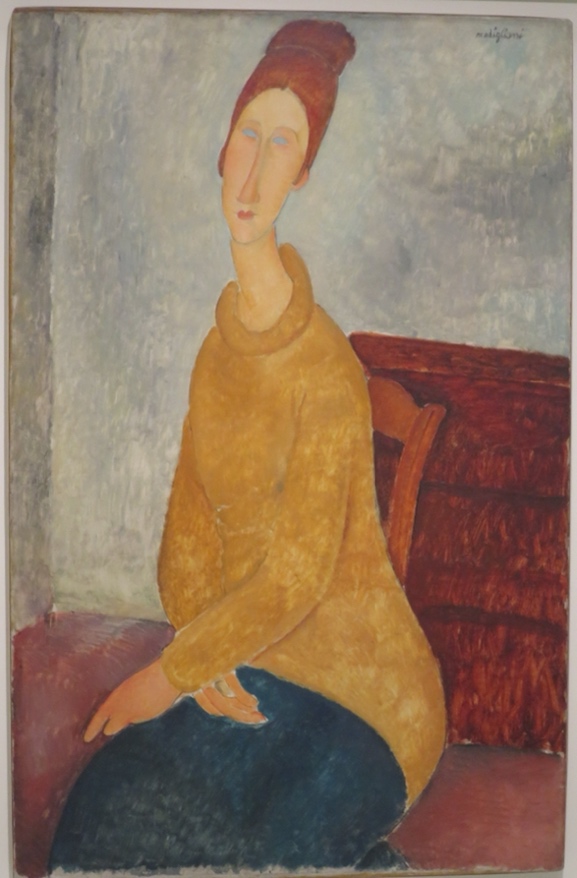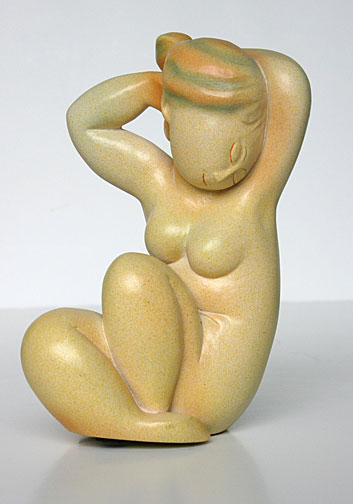5.4 NEO-PRIMITIVISM
Neo-Primitivism
Exploration and colonialism brought new ideas to Europe in the form of African carvings and the native arts of the South Seas. Artists recognized the simplicity of abstraction in these art forms. It was powerful in ways that imitation of nature was not. For our purposes, the Neo-primitive style will be applied to art consciously adapted by sophisticated artists from authentic specimens of oceanic, African and other native art.
The Paris expositions of 1878 and 1879 brought articles from the Polynesian islands to the attention of artists and the public. Later, African carvings done by black tribesmen also began to emerge. Two new museums were founded to hold the new, exotic works of other cultures. Books began to be written on myth, ritual, art and the cultures of African and Island tribal groups. William Fleming shares that, “African art, with its indigenous geometric distortions of the human figure, its freedom from western stereotypes and the academic tradition, promised a new beginning.”1 The majority of African artists made no attempt to imitate nature. Instead, they ritually honored the spirit of the tree that they would carve before they even began their work. The animistic nature of African carvings came from following the grain and natural textures of the wood they carved, rather than trying to make the wood look like another material. This fascinated abstractionists. German Expressionists were drawn to the unusual shapes and forms as well as to the non-intellectual nature of these sculptures.
The painting and sculpture of Amedeo Modigliani
While Paul Gauguin had experimented with the bright color and atmospheric impressions of island culture, his work is still quite representative. For him, form and design were more important than imitations of nature. His inspiration came primarily from his stay in Tahiti. Painting in this way Gauguin led the way toward a Neo-primitive approach to picture making. The Neo-primitive approach is taken a step further in the work of Amedeo Modigliani (1884-1920).


Note how Modigliani’s painting borrows the simplicity of the faces seen in African masks. He also uses the often-elongated oval of the face seen in many African masks much like those in the image above. Modigliani maintains the same simplicity in his choices of color. Although he chooses a limited color palette consisting of two opposite colors, he does not use the clashing brightness seen in Expressionistic images such as Munch’s The Scream. His image is instead primarily expressionless. He incorporates the blankness of the eyes seen in the masks rather than using the face to evoke emotion. Much as the masks reveal that they are made of wood, (or in some cases metal) Modigliani allows the flatness of his canvas to be clearly seen. The large swaths of nearly uninterrupted color flatten the image, defying the image of corner of the room, which when isolated can be read as an indication of depth.
Modigliani became so fascinated by African sculpture that for a time, he put down his brushes and began to sculpt. Below is a lovely piece he created using many of the same ideas seen in his paintings. He reduces the shapes to their simplest forms and allows the material to determine the look of his final piece. Modigliani drew more than seventy drawings of caryatids, female figures holding something above their heads. These figures are quite common in African carvings. Female figures are depicted holding headrests, cups, ritual objects and many other items. The sculpture of a caryatid done from these drawings is seen below. While the figure no longer holds anything up, other than her hair, her positioning is the same as if she were doing so.

While the sculpture does seem to evoke a feeling of contentment, emotion is still subservient to the shapes and colors used. Again, the artist uses two opposite colors, blue and orange, and he uses them in a subtle way, rather than presenting them as bright and clashing. There is little attempt to indicate bone structure (as there would be in a realistic sculpture). Instead, the woman is made up of a series of ovals and spheres. Notice that it is impossible to identify the elbow of the arm that disappears behind the head. Even the hair is handled by using overlapping oval shapes. The head itself is an oval and does not appear to be attached to the body in the normal way.
Constantin Brancusi’s sculpture
Constantin Brancusi, (1876-1957) a friend of Modigliani who also lived and worked in Paris, may have exerted some influence on Modigliani’s brief (about four years) sculpture period. To see how Brancusi applies the Neo-primitive approach to two of his most famous sculptures, each in a different medium, view the brief videos by clicking on the hyperlinks in the line below.
Brancusi’s The Kiss 5:26
If you receive an error with the link above, use the following link https://www.khanacademy.org/humanities/ap-art-history/later-europe-and-americas/modernity-ap/v/btheki
If you receive an error with the link above, use the following link https://www.khanacademy.org/humanities/art-1010/cubism-early-abstraction/school-of-paris/v/brancusi-bird-in-space-1928
Stravinsky and Nijinsky, expressionistic primitivism
As discussed earlier, Stravinsky and Nijinsky’s collaboration in the “Ballet,” Rite of Spring, is clearly an expressionistic endeavor. It is also distinctly Neo-primitive. Like the artworks discussed above, this piece follows the expectations of the Neo-primitive style.
- The artists seek simplicity of form, based on their interpretation of primitive work.
- The work is intended to present the essence of the subject, rather than an imitation of it.
- The work is based on ideas seen as “primitive”.
- The focus is on form and the medium is made obvious.
- Sharp angles and geometric shapes, reminiscent of those seen on African masks, form the piece.
- The works are clashes of primitive ideas and modern interpretations of them.
The incredibly complex musical score would not be considered simple by anyone who understands what it takes to play in multiple time-signatures but the multiplicity does reflect the cubist urge to present multiple views. In this way we can see a connection between the many developing styles of the time. The work is clearly based on something that the artists considered primitive. The subtitle of the ballet is, Scenes from Pagan Russia. Nijinsky’s choreography was partially based on images he saw on Greek vases. He presents these images by briefly stopping the action of the dance as if to point out this aspect of dance movement by presenting a still shot of it. The dancer’s movements, unlike those seen in traditional ballet, are angular and often seem awkward.
William Fleming shares, “Dance of the Adolescents” (a scene in the ballet) uses repetitive rhythms and syncopated accents somewhat like those of American Jazz. The sharply angular melodies, the complex textures created by multiple rhythms, the brutal accentuations, and the geometrical movements of the dancers are a masterly realization of the spirit of savagery.”5 It is not merely a coincidence that Stravinsky’s Rite of Spring contained elements of jazz. Stravinsky and many of his compatriots borrowed elements of the new American music that was taking the world by storm. In nearly every way, both the music and the choreography of Rite of Spring fit neatly in the category of art known as Neo-primitivism.

